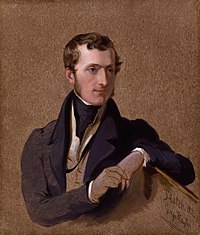5th Earl Stanhope
|
The Right Honourable The Earl Stanhope FRS |
|
|---|---|

Lord Stanhope by Sir George Hayter
|
|
| Under-Secretary of State for Foreign Affairs |
|
|
In office 17 December 1834 – 8 April 1835 |
|
| Monarch | William IV |
| Prime Minister | Sir Robert Peel, Bt |
| Preceded by | Viscount Fordwich |
| Succeeded by | Hon. William Fox-Strangways |
| Personal details | |
| Born |
30 January 1805 Walmer, Kent |
| Died |
24 December 1875 (aged 70) Merivale, Bournemouth, Hampshire |
| Nationality | British |
| Political party | Tory |
| Spouse(s) | Emily Kerrison (d. 1873) |
| Alma mater | Christ Church, Oxford |
Philip Henry Stanhope, 5th Earl Stanhope FRS (30 January 1805 – 24 December 1875), styled Viscount Mahon between 1816 and 1855, was a British politician and historian. He held political office under Sir Robert Peel in the 1830s and 1840s but is best remembered for his contributions to cultural causes and for his historical writings.
Born at Walmer, Kent, Stanhope was the son of Philip Stanhope, 4th Earl Stanhope, and the Hon. Catherine Stanhope, daughter of Robert Smith, 1st Baron Carrington. He was educated at Christ Church, Oxford, graduating in 1827.
Stanhope entered Parliament in 1830, representing the rotten borough of Wootton Basset until the seat was disenfranchised in 1832. He was then re-elected to Parliament representing Hertford. He served under Sir Robert Peel as Under-Secretary of State for Foreign Affairs between December 1834 and April 1835, and Secretary to the Board of Control in 1845, but though he remained in the House of Commons till 1852, he made no special mark in politics.
Stanhope's chief achievements were in the fields of literature and antiquities. In 1842 took a prominent part in passing the Literary Copyright Act 1842. From the House of Lords he was mainly responsible for proposing and organising the foundation of the National Portrait Gallery, London in 1856. A sculpted bust of Stanhope holds the central place over the entrance of the building, flanked by fellow historians and supporters Thomas Carlyle and Lord Macaulay. It was mainly due to him that in 1869 the Historical Manuscripts Commission was started. As president of the Society of Antiquaries (from 1846 onwards), he called attention in England to the need of supporting the excavations at Troy. He was also president of the Royal Literary Fund from 1863 until his death, a trustee of the British Museum and founded the Stanhope essay prize at Oxford in 1855. He was elected a Fellow of the Royal Society in 1827.
...
Wikipedia
